| Photojournal
- 19
August 2004
Blue
Thursday
|
Thursday was the 19th
of August. Being between semesters, I decided to take the day
and go shoot some birdies (with my camera, of course). I went
out to Boundary Bay, hoping to see the shorebirds that people
were reporting there, and not just the mud.
I arrived around 9:30,
donned my boots and hat, and ventured forth unto the mudflats.
I was greeted by a number of shorebirds close to the dyke; they
were wading through some puddles but were quite far from the actual
waterline.
|
|
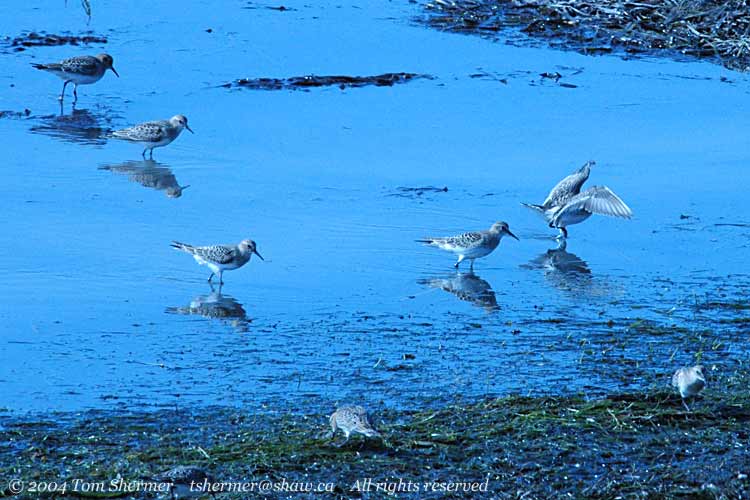 |
|
These are Baird's Sandpipers.
Baird's are small sandpipers and often classed as a "peep"
or "large peep". Peeps are the small sandpipers in the
genus Calidris; they are often quite difficult to tell
apart. The three most common North American peeps are the Western
Sandpiper, the Semipalmated Sandpiper, and the Least Sandpiper,
which all are 6 to 6.5 inches long. Baird's Sandpipers average
7.5 inches, so they're just a little bigger.
Peep and large peep
plumage is all quite similar, but basically Baird's have less
rufous (red-brown) coloration, their wings are longer compared
to their body, and they prefer drier habitat than the small peeps.
That's why they're near the dyke and not near the ocean.
Anyhow, do you see
the lovely blue color of the water in the photo above? Well, the
puddle was not that color. It was brownish, with a whitish reflection.
Notice how the white parts of the sandpipers are also blue? On
Wednesday night I had been experimenting with my camera, and I
changed the White Balance setting on it to Tungsten Lighting.
Tungsten lighting (the light from your ordinary incandescent household
light bulb) is very orange, so the camera compensates by adjusting
all of the colors towards blue. This gives a more-natural looking
photo if you're actually using tungsten lighting, but in sunlight,
it gives photos that look very blue. Very very blue. So all but
10 of the 650 or so photos I took on this expedition turned out
very blue
I've tried to adjust
many of them in Photoshop, so you won't be as assaulted by the
blue as I was. Some of it will leak through, though. Color normally
helps to distinguish between some sandpipers, but the horrid blue
makes color in these photos unreliable, making identification
harder. That's a big bummer, because I do like to identify the
birds I get photos of.
So here's another picture
of Baird's Sandpipers, up on dry land, with less blue. Their plumage
is quite good camoflage.
|
|
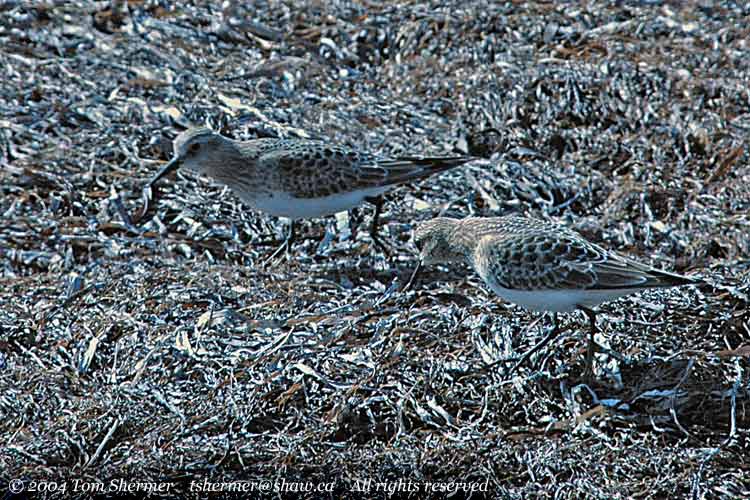 |
|
By the way, these are
juvenile Baird's Sandpipers. The plumage on adults is slightly
different.
As I walked out towards
the waterline, I encountered a few birds in the long zone between
the "near-the-dyke" zone and the "near-the-waterline"
zone. Here's one of those birds; by its size and its shape and
its bill, it's a Western Sandpiper (yes, it's a peep!). Note how
the bill is long and sorta thick and curves downward.
|
|
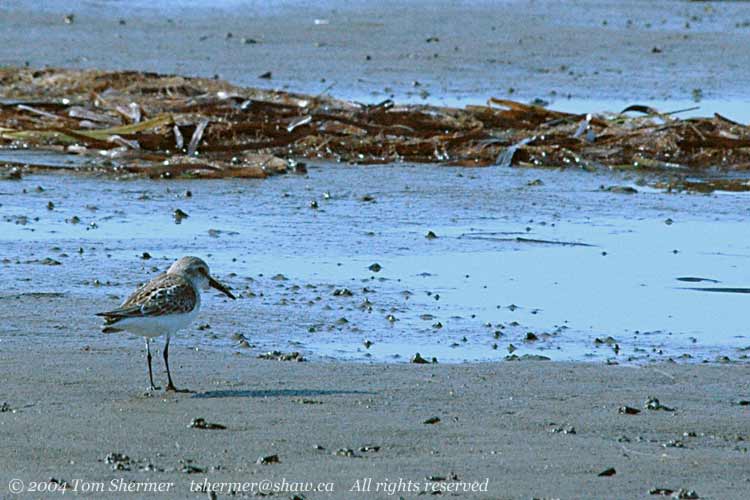 |
|
Westerns have some
variation in bill size; the one above has one of the longer ones.
The shorter Western bills are more like the bills on the Baird's.
I encountered a few groups of Western Sandpipers, from isolated
birds to flocks of eighty or a hundred or so. I could see even
larger flocks in the distance.
Also in the intermediate
zone, I caught this Semipalmated Plover making an elegant landing.
|
|
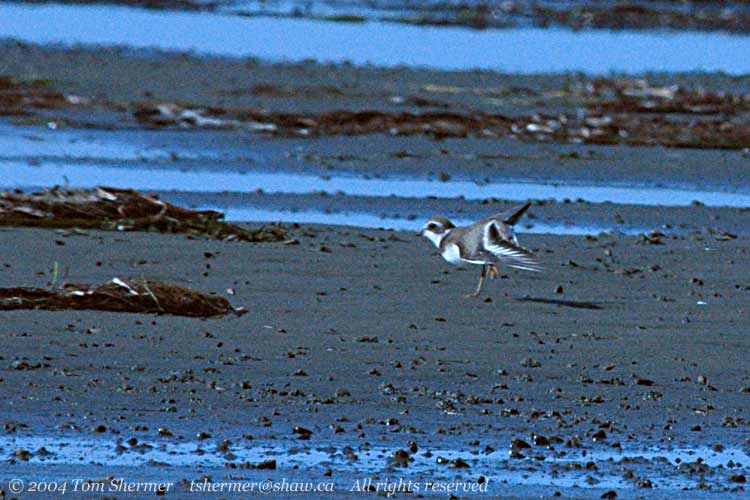 |
|
The adjective "semipalmated"
in the names Semipalmated Sandpiper and Semipalmated Plover refers
to the webbing on the birds' feet. It means that the webbing extends
only partway out the toes, not all of the way.
Anyhow, here's a later
shot of this guy, where he's showing textbook field marks, including
the single black stripe across the top of the chest, which is
not as evident in the above photo.
|
|
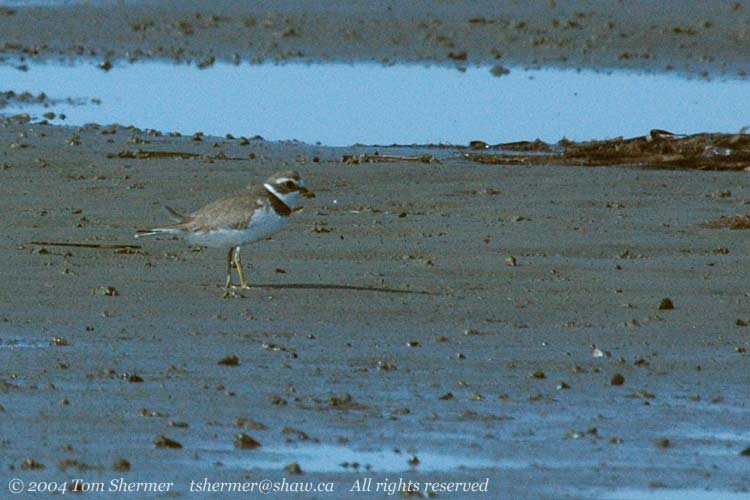 |
|
All the Semipalmated
Plovers I saw were loners.
Also in the intermediate
zone, I found the following shells. This photo shows that the
snails (the two conical shells) are leaving trails in the mud.
I had been wondering what caused the lines that I had been seeing
all over the place, and here I found out.
|
|
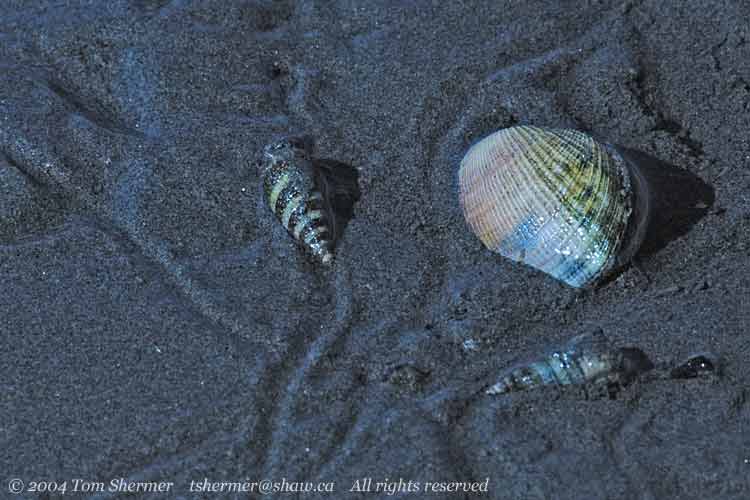 |
|
Well, that was pretty
interesting. Now that I was clued in to the snails, I had to see
if the trails were just because they were dragged by the tide
or if they were because of the snails' own powered movement. So
I started watching the snails.
And some of them were
actually moving. Not fast, mind you. They were, as you might expect,
moving at a snail's pace.
Looking around, I found
a cluster of five snails that were all going roughly the same
way: it was a snail race. Here's five photos from the snail race;
the elapsed time between the top photo and the bottom one is nineteen
seconds.
|
|
|
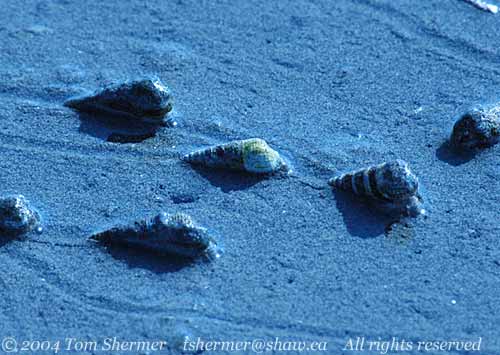
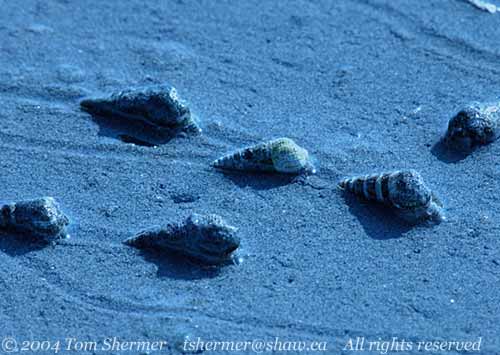
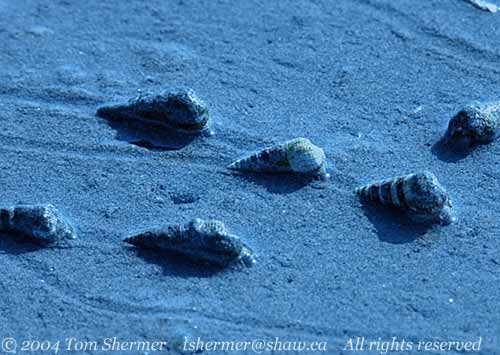
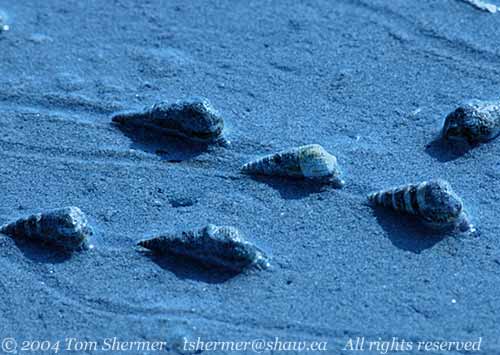
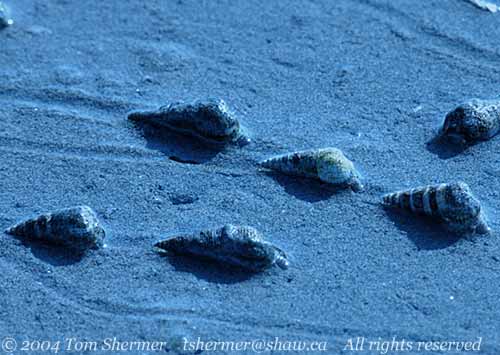
|
|
I figure these snails
were each about 2cm long. The laggard is about 1/4 in the photo
in the first frame, and all the way in the photo on the last frame.
That means that in 19 (let's say 20) seconds, it's moved about
15mm. That is 0.75mm/sec, which works out to 45mm/min or 2700mm/hr.
That's 2.7 meters in an hour! Zoooooom!
Well, didn't you always
want to know just how fast a snail's pace is?
I turned my attention
back to the birds and in about five minutes or so came upon a
medium-sized group of peeps who weren't too afraid of me. They
let me get reasonably close. Here's a group shot, which shows
no detail of the birds, but does show what a typical group looks
like out on the flats. These guys, like most of the peeps out
there, were Western Sandpipers.
|
|
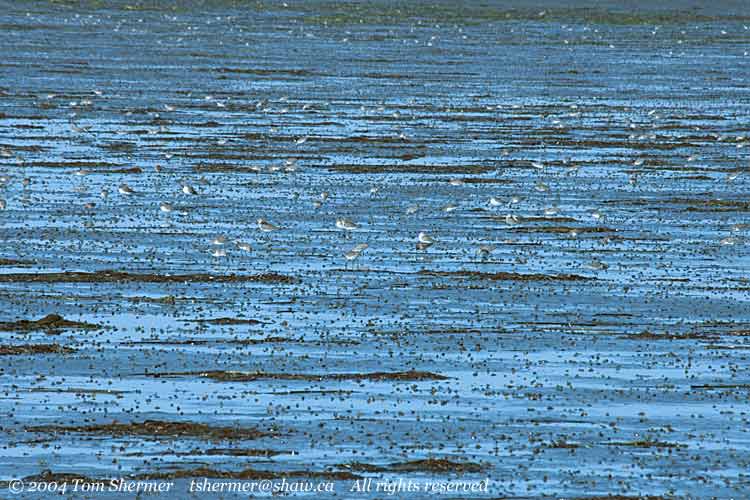 |
|
I zoomed my camera
in on them from where I was standing, but either they got antsy
about me or something else startled them, because they all flew
away.
|
|
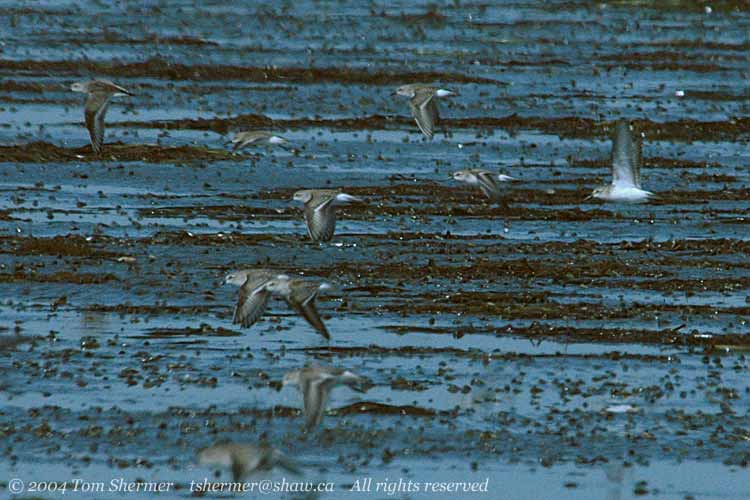 |
|
It's neat how even
a big flock can all take off within a second or so.
I walked along near
the waterline for a while, trying to get closer to some bigger
shorebirds that were hanging out right on the line. Once I was
close enough, I could see that the big guys were Black-bellied
Plovers. Here's one of them.
|
|
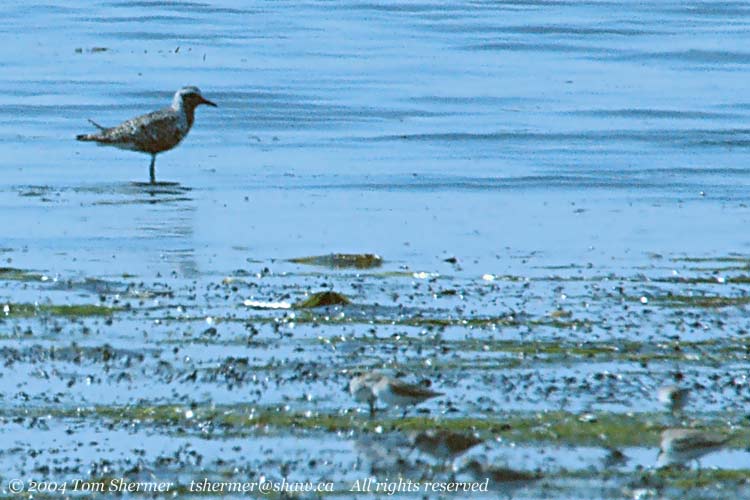 |
|
Here's a shot from
a little later, showing a good size comparison between the Great
Blue Heron, the Black-bellied Plovers, and the peeps. The photo
also illustrates what I mean when I say that image quality degrades
when I use my 2x teleconverter; the image looks grainy and a lot
like it was viewed through heat haze.
|
|
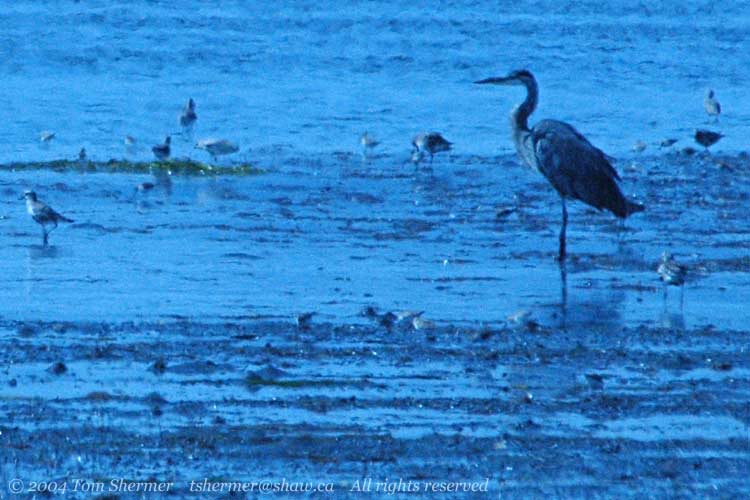 |
|
Around this time, I
found myself in very liquid mud, with my boots sinking in several
inches on each step. I guess the tide was coming in. Pulling my
foot out for each step that I took was a slow process; I was making
one step every 20 or 30 seconds. I thought about the snails. I
also thought about a newspaper article I had read about someone
who had gone out on a tidal flat in Britain somewhere and encountered
quicksand-like conditions; they got stuck and didn't make it out.
Well, comparing my mud to theirs was probably a bit dramatic,
but getting stuck in the mud or caught by the tide are real dangers
on tidal flats.
I do know basic quicksand-extrication
techniques, and I did have a fairly long pole (a.k.a. my tripod)
with me. So you needn't worry 'bout me.
It took ten or fifteen
minutes for me to extricate myself from the gloppy mud, and I
decided to head back in. It was hot outside, and I had been on
the flats for about three and a half hours already, so I was getting
tired and hungry.
On my way back in,
I saw some more Westerns, some Ring-Billed Gulls, and more Baird's.
Here's one of the gulls.
|
|
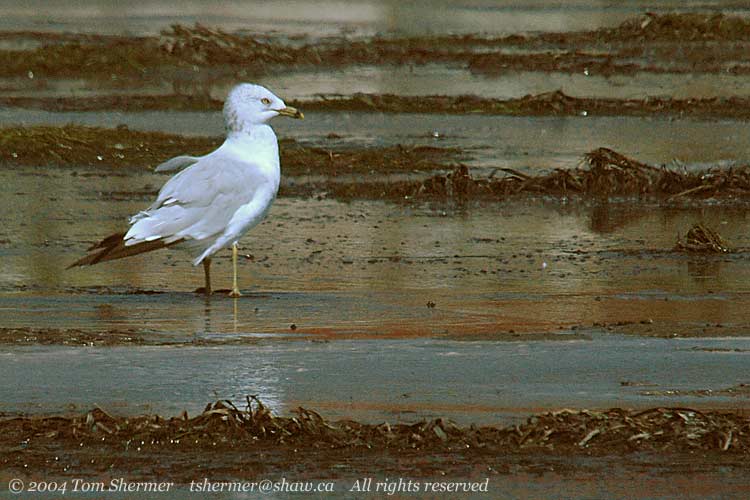 |
| As I got
back on the dyke, I noticed the White Balance setting on my camera
being off. I was really bummed. Four hours of trudging in the hot
sun to get photographs that were all going to be out of whack. Photoshop
really helped with a lot of them, but when I look at the photos,
I see the originals, and they're all blue...blue like this shot
of plovers by the water. |
|
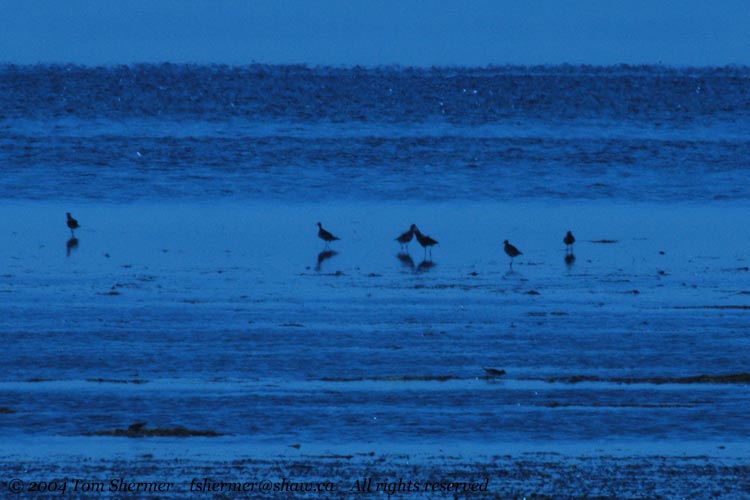 |
|
I'll leave you with
that one.
Questing for good photos,
whatever color the day may be,
Tom
|
|
|